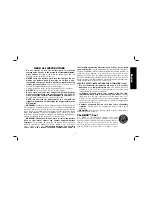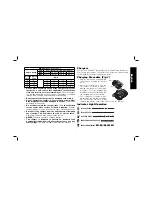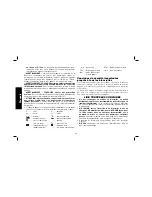
12
English
Drilling (Fig. 2)
WARNING:
To reduce the risk of personal injury,
ALWAYS
operate the tool with the side handle properly installed. Failure to do
so may result in the side handle slipping during tool operation and
subsequent loss of control. Hold tool with both hands to maximize
control.
NOTICE:
If drilling thin material, use a wood “back-up” block to
prevent damage to the material.
1. Turn the mode selector (D) to the drill symbol (I).
2. Use sharp drill bits only. For WOOD, use twist bits, spade bits,
power auger bits or hole saws. For METAL, use high-speed steel
twist drill bits or hole saws. Use a cutting lubricant when drilling
metals. The exceptions are cast iron and brass which should be
drilled dry. For MASONRY, such as brick, cement, cinder block,
etc., use carbide-tipped bits rated for percussion drilling.
3. Always apply pressure in a straight line with the bit. Use enough
pressure to keep drill biting, but do not push hard enough to stall
the motor or deflect the bit.
4. Hold tool firmly with both hands to control the twisting action of
the drill. If model is not equipped with side handle, grip drill with one
hand on the handle and one hand on the battery pack.
WARNING:
Drill may stall if overloaded causing a sudden twist.
Always expect the stall. Grip the drill firmly to control the twisting
action and avoid injury.
5.
IF DRILL STALLS
, it is usually because it is being overloaded or
improperly used.
RELEASE TRIGGER IMMEDIATELY
, remove
drill bit from work, and determine cause of stalling.
DO NOT
DEPRESS TRIGGER ON AND OFF IN AN ATTEMPT TO
START A STALLED DRILL — THIS CAN DAMAGE THE
DRILL.
Shocks – Active Vibration Control (Fig. 2)
For best vibration control, hold the tool with one hand on the main
handle (E) and the other hand on the side handle (A). Apply just enough
pressure so the hammer is approximately mid-stroke. The hammer only
needs enough pressure to engage the internal active vibration control.
Applying too much pressure will not make the tool drill faster and active
vibration control will not engage.
SDS Chuck (Fig. 6)
To insert bit
, insert shank of bit about 3/4" (19 mm) into chuck (L).
Push and rotate bit until it locks in place. The bit will be securely held.
To release bit,
pull the sleeve (M) back and remove the bit.
FIG. 6
M
L




































